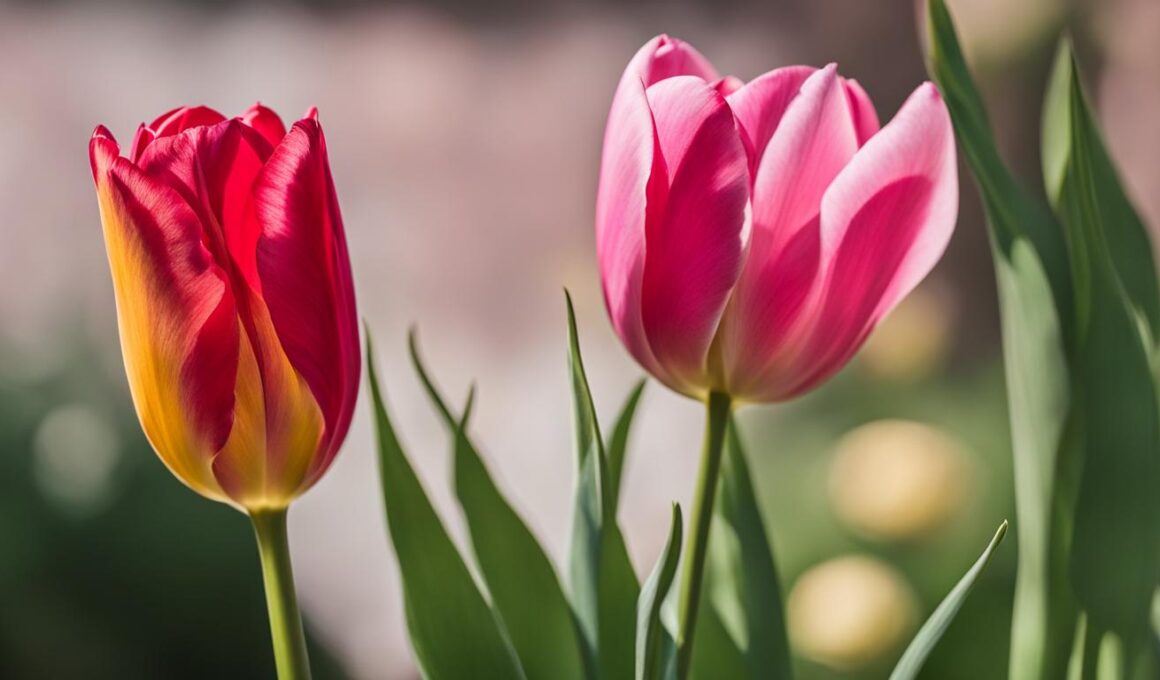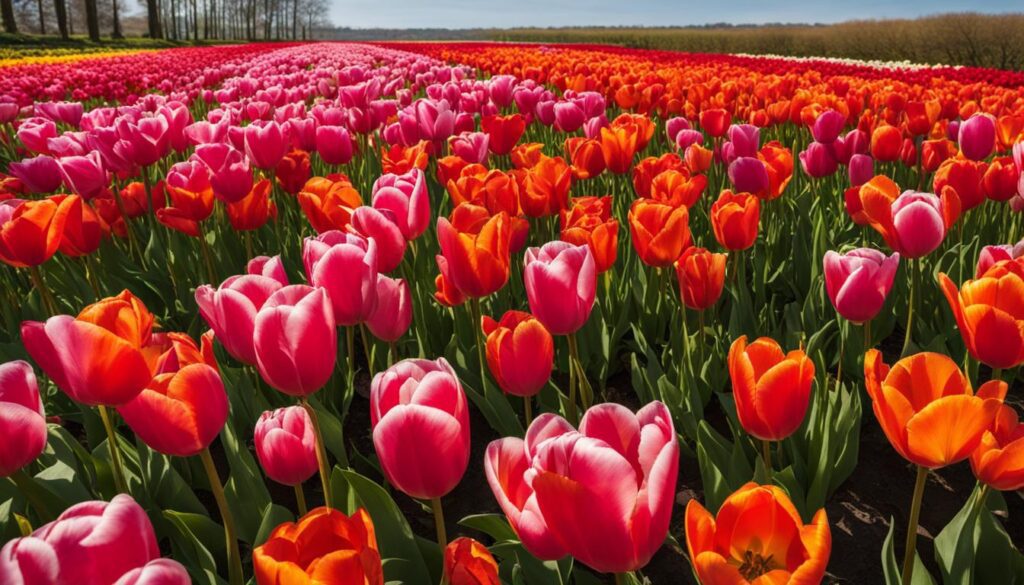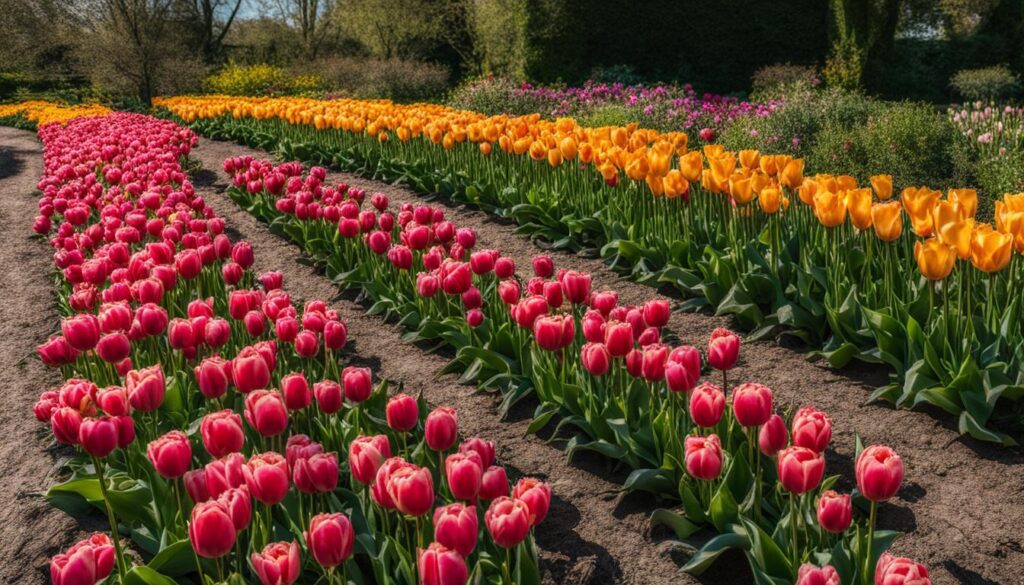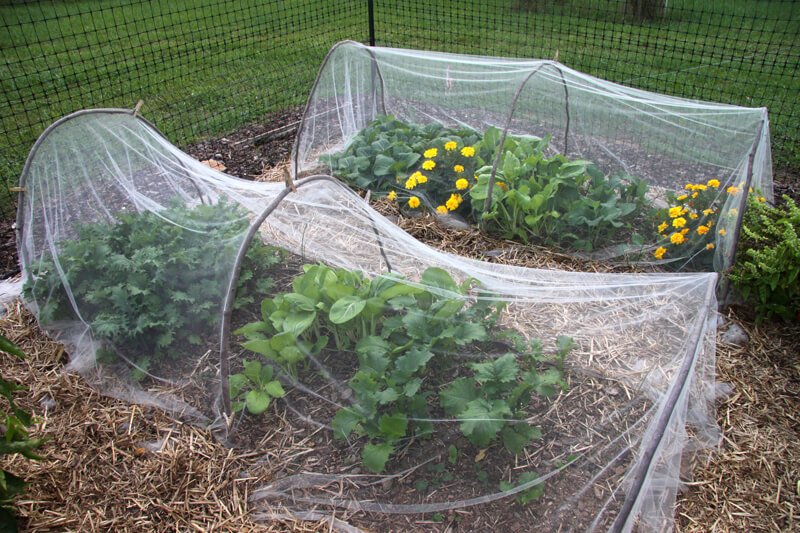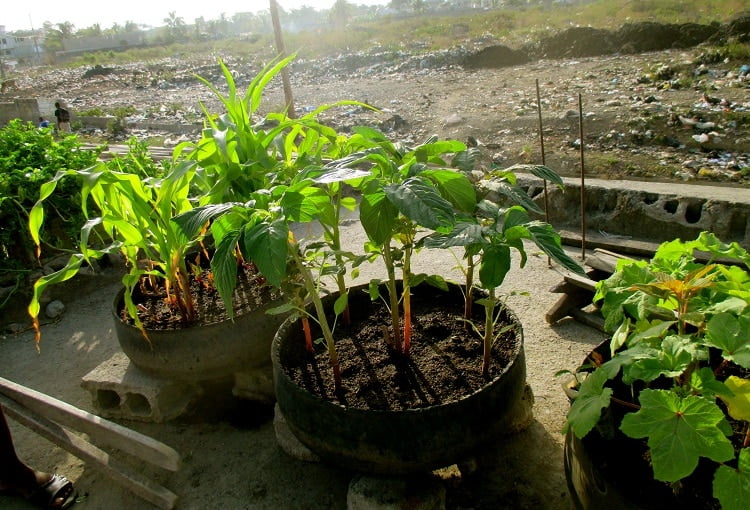Roses and tulips are both beloved flowers that capture our hearts with their beauty and charm. While they share the commonality of being flowers, there are distinct differences between these two floral wonders. In this article, we will explore the unique characteristics of tulips and roses, comparing them in terms of appearance, blooming period, susceptibility to pests, and more. By the end, you’ll have a deeper understanding of the differences between tulips and roses, helping you choose the perfect flower for your needs.
Post Summary
- Tulips and roses are both beautiful flowers, each with their own unique qualities and characteristics.
- Tulips are known for their rich content of organic acids, fatty acids, and skin protective properties.
- Roses, on the other hand, boast vibrant colors, various petal shapes, and a longer blooming period.
- Tulips are less susceptible to pests, while roses require more maintenance and are prone to fungal infections, aphids, and other garden pests.
- Tulips and roses offer different nutrients and skin benefits, contributing to the overall health and condition of the skin.
An In-depth Look at Tulips
Tulips are bulbous flowers that come in a wide variety of colors, making them a vibrant addition to any garden or floral arrangement. These beautiful blooms not only add visual appeal but also offer various characteristics that make them unique.
One notable feature of tulips is their rich content of organic acids, which possess antioxidant and antimicrobial properties. These organic acids, such as succinic acid, decanoic acid, and lauric acid, contribute to the hydration of the skin and promote moisturization. Tulips also contain a diverse range of flavonoids, which provide skin protective properties. These compounds help shield the skin from external factors and maintain its overall health and vitality.
Additionally, tulips contain a higher overall amount of amino acids compared to roses. Amino acids play a crucial role in enhancing skin brightness, hydration, and protection against environmental toxins. With their impressive array of nutrients and compounds, tulips offer numerous benefits for skincare and overall well-being.
| Tulip Characteristics | Details |
|---|---|
| Organic Acids | Rich in antioxidant and antimicrobial properties |
| Fatty Acids | Promote moisturization and skin sensitivities |
| Flavonoids | Provide skin protective properties |
| Amino Acids | Contribute to skin brightness, hydration, and protection |
Organic Acids
Tulips are a rich source of organic acids, such as succinic acid, decanoic acid, and lauric acid. These organic acids offer antioxidant and antimicrobial properties, which can help target aging concerns and hydrate the skin.
Fatty Acids
Fatty acids found in tulips, including well-known ones like succinic acid, decanoic acid, and lauric acid, promote moisturization and help with skin sensitivities. These fatty acids contribute to the overall health and condition of the skin.
Amino Acids
Tulips contain a higher overall amount of amino acids compared to roses. Amino acids play a crucial role in maintaining skin brightness, hydration, and protection against environmental toxins. This makes tulips a beneficial ingredient in skincare products.
Exploring the Beauty of Roses
Roses are undoubtedly one of the most beautiful and iconic flowers in the world. Known for their vibrant colors and captivating fragrance, roses have a unique ability to captivate the senses. With their wide range of hues, including red, white, pink, and yellow, roses offer a breathtaking display of beauty and diversity.
Apart from their stunning appearance, roses are also renowned for their exquisite petals. Each rose petal is delicately layered upon one another, creating a visually pleasing and intricate structure. The shape of rose petals can vary, with teardrop-shaped and cone-shaped petals being among the most common.
The size of roses is another remarkable aspect of their beauty. From compact varieties that reach a height of 8 inches to towering bushes that can grow up to 50 feet tall, roses come in various sizes to suit different preferences and gardening spaces. Their impressive height range allows for endless possibilities when it comes to designing a garden or floral arrangement.
| Aspect | Description |
|---|---|
| Appearance | Roses are known for their vibrant colors and captivating fragrance. They come in shades of red, white, pink, and yellow, creating a visually stunning display. |
| Petals | Rose petals are delicately layered, with different shapes including teardrop-shaped and cone-shaped. |
| Size | Roses can vary in height, ranging from compact varieties at 8 inches to towering bushes that can reach up to 50 feet tall. |
| Blooming Period | Roses bloom from late spring until fall, providing a prolonged period of beauty and fragrance. |
| Sensitivity to Pests | Roses are susceptible to various pests and diseases, including fungal infections, aphids, beetles, and spider mites. |
“A rose by any other name would smell as sweet.” – William Shakespeare
In addition to their inherent beauty, roses have also had a significant cultural impact throughout history. They have been used as symbols in literature, art, and expression, representing love, beauty, and passion. The mesmerizing fragrance of roses has long been associated with romance, making them a popular choice for gifts and special occasions.
However, it’s important to note that roses require proper care and maintenance due to their sensitivity to pests and diseases. Regular pruning, pest control, and adequate sunlight and watering are essential for keeping roses healthy and thriving. By providing the necessary care, you can ensure that your roses continue to grace your garden with their beauty and fragrance.
Appearance and Size Comparison
When it comes to the appearance of tulips and roses, while they may seem similar at first glance, there are notable differences that set them apart. Tulips come in a wide variety of bright colors ranging from white, yellow, orange, red, pink, purple, to violet. Their petals are typically bell-shaped and consist of three distinct outer petals. On the other hand, roses offer a beautiful array of colors such as red, white, light pink, deep pink, and various shades of yellow. What makes roses stand out is their intricate petal structure, with up to 60 layers of petals giving them a fuller and more luxurious look.
In terms of size, tulips generally grow smaller in height compared to roses. Tulips typically range from 6 inches to around 2 feet tall. Meanwhile, roses can vary significantly in size, with some varieties growing as small as 8 inches and others towering up to an impressive height of 50 feet. This difference in size allows for various landscaping possibilities depending on your preferences and available space.
| Tulip | Rose | |
|---|---|---|
| Colors | Bright and diverse: white, yellow, orange, red, pink, purple, violet | Wide range: red, white, light pink, deep pink, various shades of yellow |
| Petal Structure | Bell-shaped with three distinct outer petals | Layers of petals, up to 60 per flower |
| Size | 6 inches to 2 feet tall | 8 inches to 50 feet tall |
When considering the appearance and size of tulips and roses, it ultimately comes down to personal preference and the aesthetic you wish to achieve. Whether you prefer the vibrant colors and unique bell-shaped petals of tulips or the romantic allure and larger size of roses, both flowers offer their own distinct beauty that can enhance any garden or floral arrangement.
Blooming Period and Life Cycle
Understanding the blooming period and life cycle of tulips and roses is essential for successful gardening and choosing the right flowers for your landscape.
Tulip Blooming Period
Tulips have a specific blooming period, typically occurring in mid-to-late spring. This means that they will burst into colorful blooms during this specific time frame, adding beauty to gardens and landscapes. It’s important to note that tulips are perennials, meaning they can regrow each year. However, they require a period of frost in order to bloom again. Tulips mainly grow back in specific regions like South Asia and the Middle East, where the necessary cold weather conditions exist.
Rose Blooming Period
Roses, on the other hand, have a longer blooming period compared to tulips. They begin blooming in late spring and continue to produce flowers until the fall season. Some rose varieties even have the ability to withstand a brief snowfall, allowing them to bloom longer into the year. Roses, like tulips, are perennials and can grow back each year if properly cared for. However, their peak blooming time is during the spring when they display an abundance of colorful and fragrant blooms.
Tulip Life Cycle
Tulips have a fascinating life cycle that starts with the planting of bulbs in the fall. These bulbs remain dormant during the winter months, undergoing a period of cold stratification that is necessary for proper growth and blooming. As the temperatures begin to rise in the spring, the bulbs start to sprout and send up vibrant green shoots. These shoots develop into tall stems, and eventually, the tulip flowers bloom in all their glory. After the blooming period, the flowers fade and wither away, and the plant focuses its energy on storing nutrients in the bulb for the following year’s growth cycle.
Rose Life Cycle
Roses also have a life cycle that starts with the planting of young rose bushes or bare-root plants. They require proper soil preparation and regular watering to establish strong root systems. As the roses mature, they begin to produce buds that eventually open into beautiful and fragrant flowers. After the blooming period, the spent flowers are pruned off to encourage more blooms throughout the season. In the fall, when the temperatures drop, rose bushes go through a period of dormancy, shedding their leaves and preparing for winter. With proper care, mature rose bushes can continue to thrive and produce blooms year after year.
Understanding the blooming period and life cycle of tulips and roses allows you to plan and cultivate a beautiful garden that is filled with vibrant colors and fragrant blooms throughout the year. Whether you prefer the short-lived but stunning tulips in spring or the extended blooming period of roses, both flowers offer their unique beauty and charm to enhance any garden.
| Tulips | Roses | |
|---|---|---|
| Blooming Period | Mid-to-late spring | Late spring to fall |
| Life Cycle | Perennial, requires frost for regrowth | Perennial, can regrow each year |
Susceptibility to Pests
When it comes to pest resistance, tulips have an advantage over roses. Tulips are surprisingly hardy flowers and are less susceptible to common garden pests. The main threats to tulip plants include squirrels, small rodents, rabbits, deer, and skunks. To protect your tulips, it’s recommended to use enclosures or animal repellents.
Roses, on the other hand, are generally more vulnerable to garden pests. They are susceptible to fungal infections like blackspot, aphids, beetles, spider mites, and thrips. Taking regular pest control measures and using products like neem oil or pesticides can help maintain the health of your roses.
It’s important to note that roses also have higher maintenance requirements compared to tulips. Roses thrive in warm and sunny conditions, and regular pruning, pest control, and proper sunlight and watering are necessary to keep them healthy.
Pest Susceptibility Comparison
| Flower | Pests | Maintenance Requirements |
|---|---|---|
| Tulips | Squirrels, small rodents, rabbits, deer, skunks | Lower maintenance |
| Roses | Fungal infections (blackspot), aphids, beetles, spider mites, thrips | Higher maintenance |
As shown in the table, tulips have fewer issues with pests compared to roses. However, it’s important to remember that proper care and maintenance are essential for any flower to thrive. By taking the necessary precautions and following good gardening practices, you can enjoy the beauty of both tulips and roses in your garden.
“Tulips are surprisingly hardy flowers and are less susceptible to common garden pests.”
Nutrients and Skin Benefits
Tulips and roses offer different nutrients and skin benefits. Tulips contain a higher amount of amino acids, which contribute to skin brightening, hydration, and protection against toxins. These amino acids help to enhance the overall condition and health of the skin, leaving it looking radiant and revitalized. Roses, on the other hand, are rich in vitamins, calcium, vitamin E, iron, and vitamin A, offering nourishment and rejuvenation for the skin. These nutrients provide essential support for skin health and can help to improve its texture and tone.
Both tulips and roses have unique properties that make them beneficial for skincare. Tulips’ high amino acid content helps to protect the skin from environmental damage and maintain its natural moisture balance. In contrast, roses’ vitamin-rich profile provides antioxidants that combat free radicals and promote a youthful complexion. These flowers can be incorporated into skincare routines through the use of floral-infused products or DIY recipes.
When it comes to choosing between tulips and roses for skincare, it ultimately depends on individual preferences and the specific needs of the skin. Some people may find that tulip-based products work best for them, while others may prefer the effects of rose-infused skincare. Experimenting with different floral extracts can help you determine which flower provides the most noticeable benefits for your skin type and concerns.
Overall, both tulips and roses have their own unique nutrients and skin benefits. Whether you decide to incorporate tulips or roses into your skincare routine, you can expect to reap the rewards of these beautiful flowers. So why not indulge in some floral skincare and let the rejuvenating power of nature enhance your beauty routine?
Cost and Maintenance Requirements
When considering the cost and maintenance requirements of tulips and roses, there are some key differences to take into account. While tulips generally have a lower cost compared to roses, the difference is usually marginal. Both flowers are widely available and can be purchased at similar prices. For example, a dozen tulips and a dozen roses are usually priced similarly.
When it comes to maintenance, tulips are generally easier to grow and require less care compared to roses. Tulips are surprisingly hardy flowers and are less susceptible to common garden pests. They require minimal pruning and can thrive in a variety of conditions. On the other hand, roses have higher maintenance requirements. They need regular pruning to promote healthy growth and bloom. Additionally, roses are more susceptible to pests and diseases, requiring regular pest control routines and specific care to avoid issues such as fungal infections and aphid infestations. They also thrive in warm and sunny conditions.
While roses require more attention and care, the beauty they bring to any garden or bouquet is worth the additional effort. However, if you are looking for a low-maintenance option that still offers stunning blooms, tulips may be the better choice for you.
Comparison of Cost and Maintenance Requirements
| Cost | Maintenance | |
|---|---|---|
| Tulips | Lower | Easier |
| Roses | Slightly higher | More demanding |
In conclusion, while both tulips and roses possess their own unique fragrances, it is the cultural impact of roses that truly sets them apart. Roses have become ingrained in our society and carry deep symbolism, making them a timeless and beloved flower. Whether it is their association with love and romance or their captivating scent, roses have left an indelible mark on our culture, making them a cherished and revered flower.
Real Roses That Last a Year® from Venus ET Fleur
For those seeking a long-lasting symbol of beauty, Venus ET Fleur offers real roses that can stay fresh and vibrant for up to a year. These roses are carefully sourced from Ecuador, known for producing some of the most exquisite blooms in the world. Each rose undergoes a special preservation process that allows it to maintain its natural beauty and fragrance for an extended period of time.
With a wide selection of colors to choose from, including classic red, elegant white, and romantic pink, you can find the perfect rose to suit any occasion or preference. Whether you’re looking to impress a loved one or enhance the ambiance of your home or office, these long-lasting roses are a stunning choice.
Unlike traditional roses that wilt and fade within a week or two, these preserved roses offer a timeless beauty that requires minimal maintenance. There’s no need for water or sunlight, making them a hassle-free option for busy individuals or those without a green thumb. Simply display them in a vase or decorative arrangement, and they’ll continue to exude their luxurious charm for months on end.
When it comes to gifting, Venus ET Fleur’s real roses that last a year are a truly memorable and unique present. Each rose is delicately crafted and elegantly presented in a custom box, making it a visually stunning gift that will leave a lasting impression. Whether you’re celebrating a special occasion, expressing your love and gratitude, or simply looking to brighten someone’s day, these long-lasting roses are a thoughtful and meaningful choice.
Conclusion
In conclusion, when it comes to choosing between tulips and roses, it ultimately depends on your personal preferences and specific needs. Both flowers have their own unique qualities and characteristics that can bring beauty and joy to any setting.
Tulips offer a wide variety of colors and come in bell-shaped petals. They have compounds and nutrients that provide skin benefits, such as amino acids for hydration and protection against toxins. On the other hand, roses have a lasting cultural impact and a more distinct fragrance. They come in various shades and have layers of petals, with up to 60 petals in some varieties. Roses have had significant symbolism throughout history and are easily recognizable for their scent.
Consider your desired appearance, blooming period, maintenance requirements, and fragrance when making your choice. Tulips generally require less maintenance and have a more limited blooming period in mid-to-late spring, while roses bloom from late spring until fall and have higher maintenance requirements.
Ultimately, whether you choose tulips or roses, both flowers have their own special beauty and can serve as wonderful gifts or decorations. So, choose the right flower that speaks to your heart and enjoy the joy and beauty it brings.
Can Climbing Roses Be Compared to Tulips in terms of Beauty and Growth?
When comparing the beauty and growth of climbing roses to tulips, it’s like comparing apples to oranges. Both have their unique charm and appeal. However, with the right training climbing roses techniques, you can encourage beautiful, vertical growth and stunning displays of flowers in your garden.
FAQ
Are tulips and roses similar in appearance?
While tulips and roses may appear aesthetically similar, they have distinct differences in terms of color variety and petal shape.
When do tulips and roses bloom?
Tulips typically bloom in mid-to-late spring, while roses bloom from late spring until fall, with some varieties able to survive a brief snowfall.
Are tulips or roses more susceptible to pests?
Tulips are surprisingly hardy and less susceptible to common garden pests, while roses are generally more susceptible to fungal infections, aphids, beetles, spider mites, and thrips.
What nutrients and skin benefits do tulips and roses offer?
Tulips contain a higher amount of amino acids, contributing to skin brightness, hydration, and protection against toxins. Roses contain vitamins, calcium, vitamin E, iron, and vitamin A, which nourish the skin.
Do tulips or roses require more maintenance?
Tulips generally require less care and maintenance compared to roses, which have higher maintenance requirements, including regular pruning, pest control, and proper sunlight and watering.
What is the fragrance like for tulips and roses?
Both tulips and roses have delightful fragrances, but the scent of roses is more distinct and easily recognizable.
Are there any long-lasting options for roses?
Yes, Venus ET Fleur offers real roses that can last up to a year with proper care. These roses are sourced from Ecuador and treated with a special solution to preserve their beauty and fragrance.





